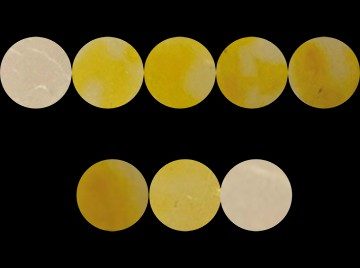FOR IMMEDIATE RELEASE
ACS News Service Weekly PressPac: August 03, 2022
Stickers and a smartphone for easy nitrite detection on foods
“Easy Nitrite Analysis of Processed Meat with Colorimetric Polymer Sensors and a Smartphone App”
ACS Applied Materials & Interfaces
Nitrates and nitrites give processed meats their characteristic pink color and robust flavor. Although many consumers want to limit consumption of these preservatives because the substances can form potentially cancer-causing compounds, knowing how much is in a food has been difficult to determine. Now, researchers reporting in ACS Applied Materials & Interfaces have developed a color-changing film that consumers can stick onto foods and easily analyze nitrite levels by snapping a picture with a smartphone.
Cured and processed meats, such as salami and bacon, are often treated with nitrite or nitrate salts to keep them looking and tasting fresh. Though nitrate is relatively stable, it can be converted to the more reactive nitrite ion in the body. When in the acidic environment of the stomach or under the high heat of a frying pan, nitrite can undergo a reaction to form nitrosamines, which have been linked to the development of various cancers. Some methods to determine nitrite levels in foods already exist, but they are not very consumer-friendly and often require expensive and laborious techniques and instruments. To help consumers make more informed decisions, Saúl Vallejos, José M. García and colleagues wanted to develop an easy-to-use nitrite quantification system.
To accomplish this, the researchers developed a film they called “POLYSEN,” which stands for “polymeric sensor,” made of four monomers and hydrochloric acid. Disks punched from the material were placed on meat samples for 15 minutes, allowing the monomer units and acid in the film to react with nitrite in a four-step azo coupling reaction. The disks were then removed and dipped in a sodium hydroxide solution for one minute to develop the color. When nitrite was present, the film’s yellowish hue deepened with higher nitrite levels in the food. To quantitate the color change, the researchers created a smartphone app that self-calibrates when a chart of reference disks is photographed in the same image as the sample disks.
The team tested the film on meats they prepared and treated with nitrite, in addition to store-bought meats, and found that the POLYSEN-based method produced results similar to those obtained with a traditional and more complex nitrite detection method. In addition, POLYSEN complied with a European regulation for migration of substances from the film to the food. The researchers say the new approach could be a user-friendly and inexpensive way for consumers to determine nitrite levels in foods.
The authors acknowledge funding from La Caixa Foundation and the Spanish Agencia Estatal de Investigación. They also acknowledge the support and collaboration of the company Inforapps.
###
The American Chemical Society (ACS) is a nonprofit organization chartered by the U.S. Congress. ACS’ mission is to advance the broader chemistry enterprise and its practitioners for the benefit of Earth and all its people. The Society is a global leader in promoting excellence in science education and providing access to chemistry-related information and research through its multiple research solutions, peer-reviewed journals, scientific conferences, eBooks and weekly news periodical Chemical & Engineering News. ACS journals are among the most cited, most trusted and most read within the scientific literature; however, ACS itself does not conduct chemical research. As a leader in scientific information solutions, its CAS division partners with global innovators to accelerate breakthroughs by curating, connecting and analyzing the world’s scientific knowledge. ACS’ main offices are in Washington, D.C., and Columbus, Ohio.
To automatically receive press releases from the American Chemical Society, contact newsroom@acs.org.
Note: ACS does not conduct research, but publishes and publicizes peer-reviewed scientific studies.
Media Contact
ACS Newsroom
newsroom@acs.org

View larger image

